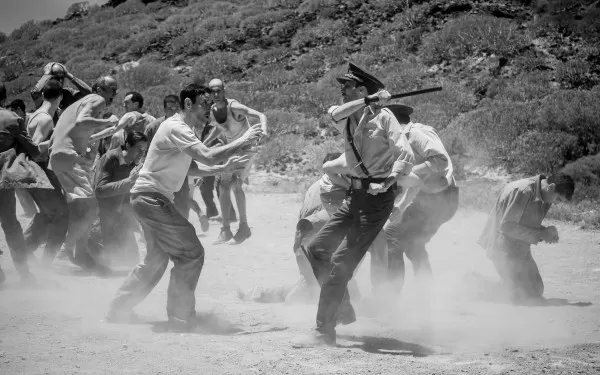
Nights in Tefía: het vergeten verhaal achter de serie
Een verborgen geschiedenis
Fuerteventura roept beelden op van zon, zand en rust, maar midden in dit landschap lag in de jaren vijftig een plek van onderdrukking en angst: de Penitentiary Agricultural Colony van Tefía. Dit werkkamp maakte deel uit van het repressieve systeem van dictator Francisco Franco, die Spanje van 1939 tot 1975 met harde hand regeerde.
Onder zijn bewind werden niet alleen politieke tegenstanders vervolgd, maar ook mensen die als sociaal of moreel ‘afwijkend’ werden beschouwd, waaronder homoseksuelen. Op basis van de Ley de Vagos y Maleantes, de Wet op Landlopers en Vagebonden, konden zij zonder proces worden opgesloten in zogenoemde heropvoedingskampen. Wat officieel bedoeld was om de samenleving te beschermen, bleek in werkelijkheid een systeem van dwangarbeid, vernedering en isolement.

Het dagelijks leven in Tefía was zwaar: dagenlang stenen sjouwen, water dragen, militaire gymnastiek, en voortdurende angst voor mishandeling door de bewakers. De kolonie bleef elf jaar in gebruik, tot 1966, en huisvestte honderden gevangenen, onder wie tientallen die enkel vanwege hun geaardheid vastzaten.
Waar geschiedenis en verbeelding elkaar ontmoeten
Nights in Tefía brengt dit vergeten verleden tot leven door de ogen van Airam Betancor, die als tiener in het kamp belandt. Tussen het geweld en de vernederingen in creëert hij samen met andere gevangenen een denkbeeldige nachtclub: La Tindaya. In deze fantasiewereld vinden ze even vrijheid, humor en menselijkheid terug, een symbolisch verzet tegen het systeem dat hen hun identiteit ontneemt.

Regisseur Miguel del Arco vertelt het verhaal in lagen: het verleden in zwart-wit, het heden in kleur en de scènes in La Tindaya in een droomachtige gloed. Zo laat hij zien hoe herinnering en verbeelding kunnen helen en hoe kunst een manier wordt om trauma om te zetten in kracht.
Een vergeten hoofdstuk in beeld
Nights in Tefía is meer dan een historische dramaserie. De reeks brengt een onderbelicht deel van de Spaanse geschiedenis in beeld en richt de aandacht op de LGBTI+-personen die tijdens het Franco-regime werden vervolgd en langdurig uit het publieke geheugen zijn verdwenen.

Nights in Tefía is vanaf 1 november elke zaterdag om 21.00 weer te zien op OUTtv.







I found the background on the Penitentiary Agricultural Colony in Tefía really eye-opening. It’s striking how a place that seems so peaceful today once held such harsh realities under Franco’s regime. It seems the series does a great job of uncovering these hidden stories.